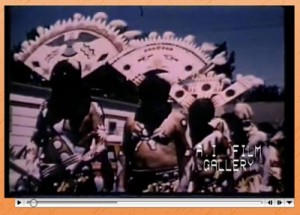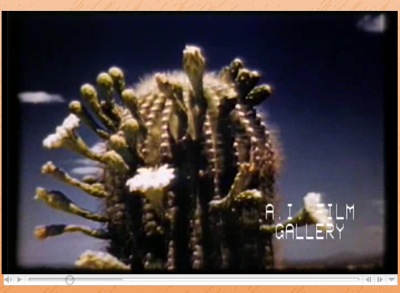The American Indian Film Gallery Retrieves Images from 20th Century Life
posted May 22, 2010 2 Comments
![]()
By Peter Monaghan
A Hollywood staple, for decades, was Indians yelping from pinto ponies, brandishing tomahawks with bloodcurdling cries, and plummeting rifle-shot from rocky outcrops.
If you’re entertained by braves engaging in chicanery, mass attack, or trick riding while for all the world resembling bootblackened whitemen on dusty California backlots, then you have a long tradition of American cinema at your service.
But J. Fred MacDonald’s well-stocked, new, online film archive will not be for you. The films of his collection, the American Indian Film Gallery, tend to the more mundane, and the more informative. They depict everyday settings and circumstances of Native American life during the early and mid-20th century.
J. Fred MacDonald: Still Teaching Film as History

J. Fred MacDonald certainly keeps busy in his “retirement.” In addition to mounting his American Indian Film Gallery, he has just completed his latest, archiving-inspired pedagogical e-book, The Code of Clio.
Like his earlier The History Shoppe, to which it is a sequel, The Code of Clio teaches young readers how to be a historian, and in particular how to recognize the historical significance of artifacts of popular culture. Now available for download from the Net – free of charge – the book features high-school student Scott Tennyson as he attends a summer workshop at State University and is assigned to the school’s Museum of History and Culture.
There, he encounters a variety of archival films and related materials that readers can download from links in the online book. The novel is something of a teacher’s fantasy, featuring such lines as this: “Throughout lunch Scott was eager to get back to the Museum of History and Culture. As he hurried from the cafeteria to the Museum, all he could think of was the importance of his assignment.”
Here’s where the novel becomes of particular interest to moving-image archivists. The lad’s assignment leads him to screen forgotten moving-image gems such as an obscure film from Old Gold cigarettes about the Sioux Indians called Fallen Eagle, and another one about Indian sign language called Injun Talk – two of the titles that just happen to be among those on MacDonald’s American Indian Film Gallery.
Our hero also views a corporate short entitled Fabrics from Modern Masters in which Picasso, Miro, Chagall, Leger, and Dufy sell their art as designs on bolts of commercial cloth, and a 50-minute home movie of an American couple on an automobile tour through Nazi Germany and Austria one month before the Munich Crisis and one year before the outbreak of World War II. There is even an original interview with a survivor of the desert relocation camps into which Japanese-Americans were forcefully placed by the US Army in 1942.
Also linked in the novel are other films, still images, and a political radio program in which the discussants ponder the future of rock and roll as it begins to take shape, in July 1956 – a connection that takes advantage of MacDonald’s history as a pioneer radio broadcaster of programming that placed popular culture into historical context. In 1980, 1981, and 1983, he produced a documentary series, Journeys, for WBEZ, the National Public Radio station in Chicago. Combining historical sound bits and critical interpretation, each program addressed a different historical topic, such as Sex Symbol: The Story of Marilyn Monroe; From Vampires to Slashers: The American Taste for Horror; Protest and Counter Culture in the 1960s; and We’re in the Money: Popular Culture in Depression America. MacDonald wrote and produced the programs, which are also available on his website, and hosted it with Wendy Leff. For that matter, MacDonald’s site provides a vast amount of his writing and work. It’s all online and free to access and download at www.jfredmacdonald.com while the new novel can be accessed directly online.
– Peter Monaghan
The films are all the more fascinating for that. If you wonder what an Apache dance to ward off evil spirits looked like at that time, try Apache, from about 1940. The dance comes at the culmination of a pollen-blessing dance, a coming-of-age ceremony for young women. The short film, with narration, shows how a group of eastern Arizona Indians dwelled, collected water, reared their children, and ranched.
Navajo Saintpainters, a 1941 silent Telefilm production with narration, depicts a healing ceremony. A Southwest medicine man directs the construction of an image in colored sand, then chants and administers medicinal herbs to an ill tribe member.
Like many of the films on MacDonald’s site, Navajo Sandpainters was filmed without sound, and depends on narration. The voiceover reflects some of white America’s sadder attitudes of the day: “Trouble has come to this old Indian. … How can the witchery of the wrathful god be overcome.”Says MacDonald, an emeritus professor of history at Northeastern Illinois University and well-regarded authority on the history of film and television and other popular culture: “There are some really insensitive soundtracks, but at least you get to see a lot of important imagery.”
Also posted, already, are more than 100 other films, with 400 on the way by mid-summer, 2010. They include Injun Talk (1946), which details basics of sign language among Plains Indians of the Blackfeet and Blood tribes. (Again, viewers must suffer some annoying narration.)
Before the White Man Came is a 1918 silent feature film in which all of the actors were Crow and Northern Cheyenne actors. Yakima Indian Activities, from 1939, provides silent documentation of salmon and eel harvesting at the Celilo Falls Indian fishing grounds in Oregon, as well as activities on Indian cattle ranches and at an annual hop harvest festival.
Thanks to MacDonald’s interest in making the films available to any curious visitor to his site, his film postings, all in the public domain, are available for viewing or downloading free of charge. The owner of a large collection of American films, he says that he decided to create the online archive only recently, when he realized just how many films of Native American ethnographic interest he possessed, and how few such films are broadly available. “Since I began collecting in 1972 I’ve always had a minor area of collecting in Native American films,” he says. “Now I have well over 100.”
For too long, he reasoned, American popular culture has propagated warped, unhistorical, and stereotyped images of Native Americans that cloud the judgments of researchers, students, and members of the general public. He says his collection, while lacking the narrative elements that drove the success of Hollywood depictions, nonetheless provides some entertainment and plenty of enlightenment. He will ask experts in Native American life and history to contribute explanatory essays to the site, while viewers and readers may contribute their thoughts and observations via a blog.MacDonald also is inviting them to post films from their own collections to his site. He welcomes ethnographic, rather than fiction films, and is hoping to find material from all around North and South America. He has already had interest from an archive with about 275 video tapes, including some from a 1976 when a federal Bicentennial project provided cameras to Native Americans to film their worlds. “That became a major moment in Native American culture, because it was the blossoming of Native American filmmaking,” he says.

“There are tons of films out there, and that I’ve never seen in 30 or 40 years of collecting,” says MacDonald. “And very few are available online at this point.” For whatever reason, he says, such films seem never to have been much of a collector’s item in the film world. Still, some university collections are rich in them. “In the 1940s the University of Nebraska made some wonderful ones,” he says. “And the University of Oklahoma made some. So hopefully we’ll be able to have access to those films.”
With that much traffic, MacDonald has high hopes that the site will continue to build for years to come. Soon, he says, he will begin to ask owners of copyrighted works for approval to add their films to the site. He also is putting the word out to fellow archivists who may be aware of stores of material unknown to him. He knows, already, that some universities have large holdings, among them the Universities of Pittsburgh and California at Berkeley, in addition to Nebraska and Oklahoma. And he has asked colleagues there for help locating and mounting footage.
The site includes, in addition, a long list of “lost films” that he hopes colleagues will turn up, or know about, already. His site posts films with a branding “A.I. Film Gallery” to prevent improper use.
Already the American Indian Film Gallery has had hits from more than 100 countries. The draw of the films, he says, is evident: “When you see an image of a little Indian girl holding a kitten and watching her mother make bread, it’s very humanizing.”
UPDATE: October 2010
As of October 2010, the American Indian Film Gallery (www.aifilmgallery.com) has placed online some 290 vintage films about Native American life from the Arctic to Cape Horn.
The films can be viewed and downloaded free of charge. They present aspects of the life of 102 tribes.
The gallery has another 120 films waiting to be placed online.
The project is looking for additional movies to add to post, and invites contributions from archives and libraries. To take part, contact J. Fred McDonald, macfilms@att.net, MacDonald & Associates, Chicago; 773-267-9899










This is an amazing. We will spend hours and enjoyable hours watching. Thank you.
This is fantastic, and especially interesting for me since I work with American Indians.